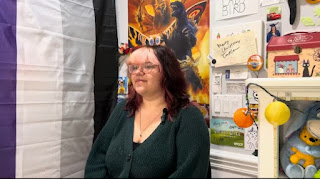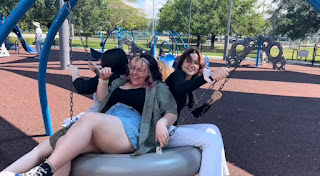We Are Young: Here & Queer is a documentary series about bringing awareness to young people in the LGBTQIA+ community with its excerpt highlighting themes of community, acceptance, awareness, and understanding. Through interviews detailing first-hand experiences and feelings garnered from being a member of the LGBTQIA+ community, the documentary shows how important it is to recognize queer youth and to uplift their voices as they are often underrepresented in society.
My excerpt of
We Are Young: Here & Queer, highlights asexuality, an often underrepresented aspect of the LGBTQIA+ community. Along with interviews, the documentary utilizes other techniques such as B-roll, diegetic sound, music, and multiple angles and perspectives to tell Tasha's, the main subject of the excerpt, story. Each of these techniques proved vital in aiding my documentary's message. These techniques were also influenced by other documentaries that inspired me including
Paris Is Burning (dir. Jennie Livingston) and
Transhood (dir. Sharon Liese). These pieces inspired me in how I approached my project and how I tackled the topics presented in my documentary, which was especially prevalent in the interviews. In
Transhood, interviews led the story by depicting how to subjects truly felt about what was happening in the world around them. This is also depicted in
We Are Young: Here & Queer. By seeing the technique used in another documentary, I was able to see the impact it had and utilize it in my piece. While these documentaries have influenced the techniques I used to present my piece, I was also inspired by my research on the Queer Youth Movement which is documented
on my blog. This research helped me fully flesh out my ideas and highlight the message of my piece, which is to bring awareness to queer youth and to bring LGBTQIA+ topics forward in a positive light. This research allowed me to do that. Through both aspects of my research, I was able to follow the conventions of the documentary genre and use techniques that elevated my piece while still sticking to the norms of the genre.

Through my research, I was also able to deduce the target audience of my documentary. We Are Young: Here & Queer is targeted towards a younger demographic of people of all genders aged ten to twenty-one, likely in or an ally of the LGBTQIA+ community and in the middle class. The documentary could also reach an older demographic of people aged between twenty-two and thirty-two, especially if they identify as members of or are activists in the LGBTQIA+ community. This demographic would also be interested in learning about LGBTQIA+ topics and are fans of other media with queer representation.
The target audience for my documentary directly correlates with the piece's representation. The main focus of my documentary is the LGBTQIA+ community, specifically teenagers. My excerpt highlights the personal struggles queer teens go through representing their identity, and how a strong bond with friends can be a great support system for someone to authentically express themselves. This is shown through interviews of the main subject and friends of theirs talking about their experiences with them. This is also shown through B-roll of the main subject having fun and spending time with their friends at a park. My excerpt also highlights asexuality. Asexuality is underrepresented in the media and when it is, it is usually shown in a stereotypical or sometimes mocking way. Most people, both in and out of the LGBTQIA+ community, don't really understand it, know what it is, or see it as a "valid" identity. By depicting a genuine account of real experiences from someone who is asexual, I am educating many on an unknown topic and giving a platform to speak about and uplift the experiences of those who may not otherwise be given a platform to speak on these important topics. My documentary is all about highlighting the queer community, being proud to express your identity, and showing others that they are not alone. By highlighting these underrepresented groups, I successfully developed my representation goals and showed society what it means to be a queer teenager.

My target audience and representation are also highlighted in We Are Young: Here & Queer's social media pages. My documentary uses Instagram as a promotional platform and YouTube for mainstream distribution. These social media platforms allow the documentary to be seen by and grow a platform with its audience. Instagram especially, gives an opportunity for the audience to engage and interact with the piece. The Instagram page further gives a behind-the-scenes look at the creative process, details what's coming next for the project, and promotes awareness for LGBTQIA+ topics. The Instagram page also offers a way for young queer people to share their stories and experiences and have them posted to the account. This makes the audience feel less alone and become more aware of what the queer experience is like which highlights the message of the piece. There are also phone wallpapers that the target audience can use to show their pride and express their identity through a device they use every day, which highlights the documentary's themes of identity and pride.

All aspects of my project, my documentary, my social media page, and my magazine spread, work together to create a brand of acceptance, community, and education about queer youth in society. Each aspect does this in different ways, but all share cohesive qualities. They represent equality and acceptance, promote awareness and education, and all use bright colors to convey an appealing and welcoming nature. Examples of this are the Instagram page spreading messages about important LGBTQIA+ ideas and using rainbow colors throughout the account. In addition, the magazine spread provides personal details on the impact of the brand, its message, and why it's so important to society. The documentary contributes to this by giving personal accounts of what it's like and showing the effects of what the brand promotes and the main theme of the brand.
Through the creation of We Are Young: Here & Queer, I have learned so much about what it means to produce something so personal and impactful. I am very proud of this portfolio project, and that I created something that uplifts the many voices of my community, especially those that may not be the most talked about. I will take everything I learned from this process and evolve it for the future.








